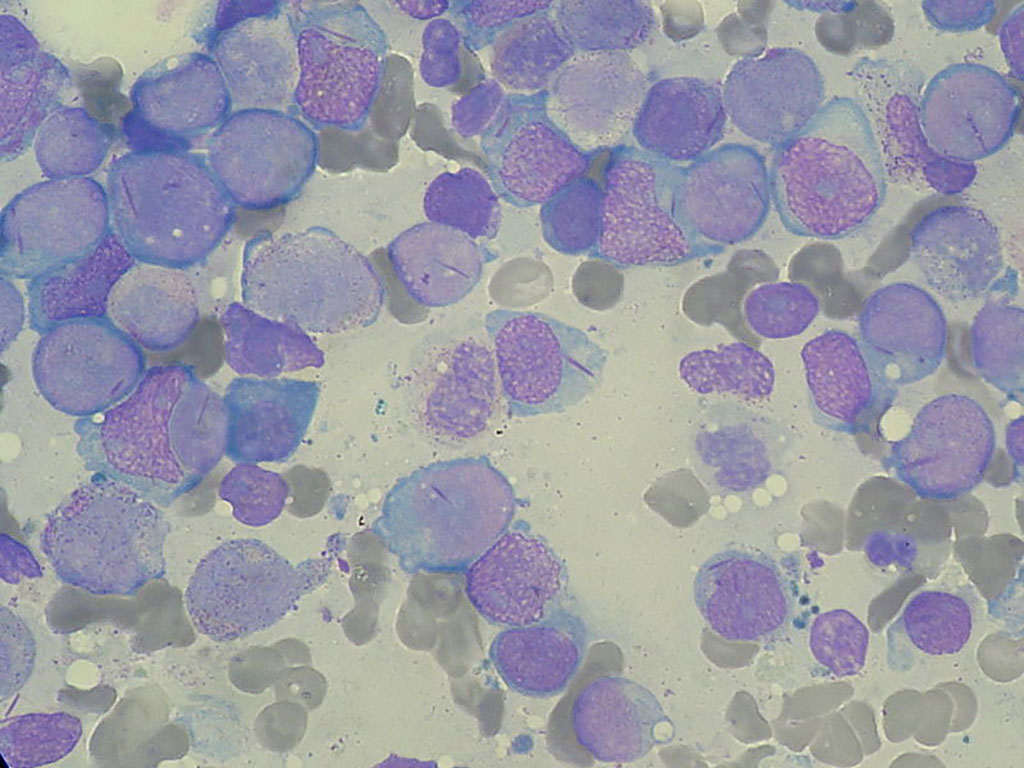Precise Measurement of DNA Length Polymorphisms Used to Diagnose Acute Myeloid Leukemia
By LabMedica International staff writers
Posted on 08 Feb 2021
By combining two powerful analytical tools, researchers have demonstrated the ability to diagnose diseases such as leukemia by quantifying both the size and proportion of DNA length polymorphisms.Posted on 08 Feb 2021
DNA length polymorphisms are found in many serious diseases, and assessment of their length and abundance is often critical for accurate diagnosis. However, measuring their length and frequency remains challenging due to their variable and repetitive nature.

Image: Bone marrow aspirate showing acute myeloid leukemia (Photo courtesy of Wikipedia Commons)
In response to this challenge, investigators at Virginia Commonwealth University (Richmond, USA) combined two powerful techniques, digital polymerase chain reaction (dPCR) and high-speed atomic force microscopy (HSAFM), to create a simple, rapid, and flexible method for quantifying both the size and proportion of DNA length polymorphisms.
PCR uses the DNA polymerase enzyme to exponentially clone samples of DNA or RNA for further experimentation or analysis. Instead of performing one reaction per well, dPCR involves partitioning the PCR solution into tens of thousands of nanoliter sized droplets. Atomic force microscopy is a type of scanning probe microscopy with demonstrated resolution on the order of fractions of a nanometer, better than 1000 times more sensitive than the optical diffraction limit. Data are gathered by "feeling" or "touching" the surface with a mechanical probe. Piezoelectric elements that facilitate tiny but accurate and precise movements on electronic command enable precise scanning.
In the current study, the investigators focused on internal tandem duplications (ITDs) located within the FLT3 gene, which are associated with acute myeloid leukemia and are often indicative of a poor prognosis. Using the combined approach, individual amplicons from each dPCR partition were imaged and sized directly. In an analysis of over 1.5 million HSAFM-imaged amplicons from cell line and clinical samples containing FLT3-ITDs, dPCR–HSAFM returned the expected variant length and variant allele frequency, down to 5% variant samples.
"The technology needed to detect DNA sequence rearrangements is expensive and limited in availability, yet medicine increasingly relies on the information it provides to accurately diagnose and treat cancers and many other diseases," said senior author Dr. Jason Reed, associate professor of physics at Virginia Commonwealth University. "We have developed a system that combines a routine laboratory process with an inexpensive yet powerful atomic microscope that provides many benefits over standard DNA sequencing for this application, at a fraction of the cost."
"We chose to focus on FLT3 mutations because they are difficult to diagnosis, and the standard assay is limited in capability," said Dr. Reed. "We plan to continue developing and testing this technology in other diseases involving DNA structural mutations. We hope it can be a powerful and cost-effective tool for doctors around the world treating cancer and other devastating diseases driven by DNA mutations."
The combined dPCR/ HSAFM procedure was described in the November 10, 2020, issue of the journal ACS Nano.
Related Links:
Virginia Commonwealth University














